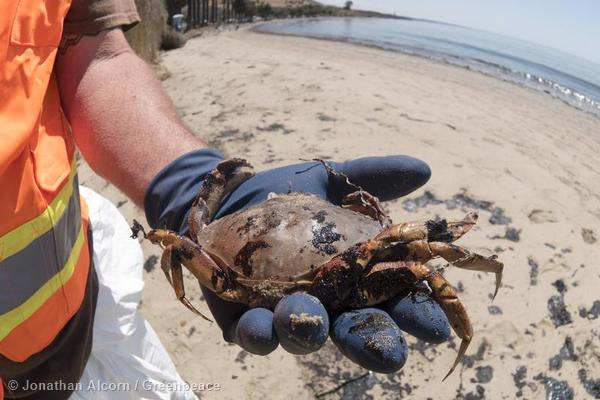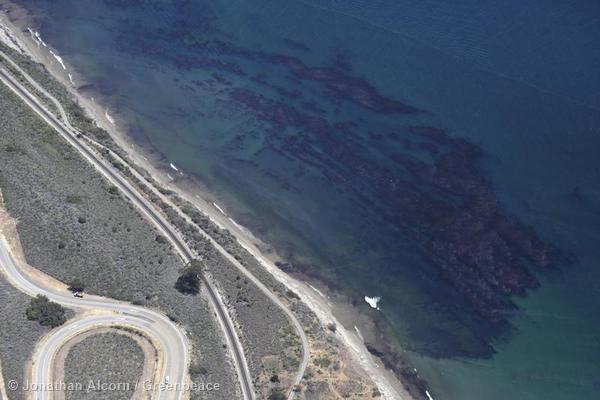 An aerial view of part of the spill on Wednesday, May 20, 2015. Photo credit: Refugio Response Information website.
An aerial view of part of the spill on Wednesday, May 20, 2015. Photo credit: Refugio Response Information website.
On Tuesday, an underground oil pipeline burst near Goleta, California, spilling crude oil into the Pacific, soiling beaches, killing marine animals, and coating birds in oil. Whales and sea lions were spotted in the spill area, where two slicks totaled 9-miles long as of Wednesday evening. The spill took place not far from the Channel Islands National Marine Sanctuary, site of an incredibly diverse marine ecosystem that is home to 18 cetacean and 3 seal species.
The ruptured pipe was discovered around 11:30 PDT on Tuesday morning, and the pipeline was shut down, according to a fact sheet posted on the spill response website. The company responsible for the spill, Houston-based Plains All American Pipeline, made a "worst-case scenario" estimate that as many as 105,000 gallons of crude oil may have leaked, of which about 21,000 gallons entered the ocean, according to the fact sheet.
Governor Jerry Brown declared a state of emergency on Wednesday evening in Santa Barbara County, where the spill took place. The state closed Refugio State Beach and El Capitán State Beach, evacuated campers, and shut down fishing and shellfish harvest in the area. A multi-agency clean-up response is under way.
The pipeline, dubbed Line 901, measures 24 inches in diameter and runs between Las Flores and Gaviota, California. It was constructed in 1987 by Plains All American Pipeline, which owns the line. The company is responsible for at least 11 other oil spills, according to news reports. The cause of the current spill and the extent of the resulting environmental damage remain under investigation.

Oil on the beach at Refugio State Beach in Goleta, California, on Tuesday, May 19, 2015. Photo credit: U.S. Coast Guard.

A dead ray, fish, and shellfish lie on Refugio State Beach on Wednesday, May 20, 2015. Photo credit: Jonathan Alcorn/Greenpeace.

Clean-up workers pass bagged debris at Refugio State Beach on Wednesday, May 20, 2015. Photo credit: Jonathan Alcorn/Greenpeace.

A clean-up worker displays a dead, oiled crab on Refugio State Beach on Wednesday, May 20, 2015. Photo credit: Jonathan Alcorn/Greenpeace.

A clean-up worker walks across oil-coated Refugio State Beach on Wednesday, May 20, 2015. Photo credit: Jonathan Alcorn/Greenpeace.

Clean-up workers at work on Refugio State Beach on Wednesday, May 20, 2015. Photo credit: Jonathan Alcorn/Greenpeace.

Workers clean Refugio State Beach on Wednesday, May 20, 2015. Photo credit: Jonathan Alcorn/Greenpeace.

Crews begin cleaning Refugio State Beach on Wednesday, May 20, 2015. Photo credit: Jonathan Alcorn/Greenpeace.

Clean-up workers bag oiled debris on Refugio State Beach on Wednesday, May 20, 2015. Photo credit: Jonathan Alcorn/Greenpeace.

Oil-soaked palm fronds lie on Refugio State Beach on Wednesday, May 20, 2015. Photo credit: Jonathan Alcorn/Greenpeace.

Sea birds fly over the Ocean Sentinel, an oil spill response vessel just off Refugio State Beach on Wednesday, May 20, 2015. An offshore oil platform sits in the distance. Photo credit: Jonathan Alcorn/Greenpeace.

Offshore oil platforms in the Pacific Ocean near the oil spill on Wednesday, May 20, 2015. Photo credit: Jonathan Alcorn/Greenpeace.

Oil clouds the water and coats the shore near Goleta, California, on Wednesday, May 20, 2015. Photo credit: Jonathan Alcorn/Greenpeace.







